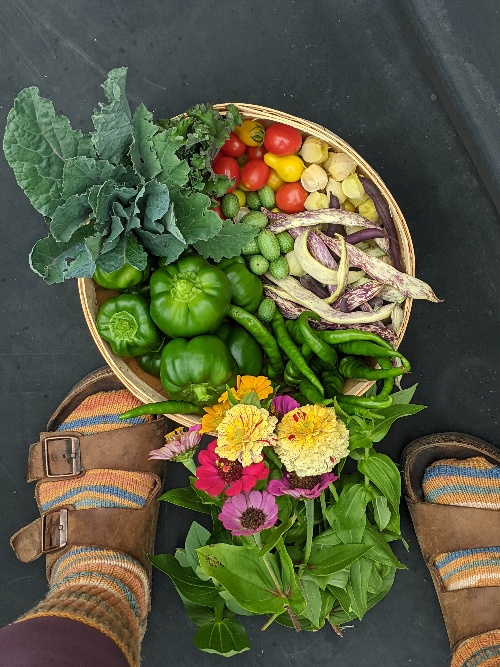
Whether you’ve been at this whole gardening thing for a while or you’re just getting started, you probably know that starting your own seeds is a game changer. But doing so means giving up a chunk of your living space for several months of the year (bye-bye dining room table). Not to mention the considerable expense of equipment.
That is unless you choose to start seeds with the snail seed-starting method.
Let’s take a look at this brilliant way of starting seeds. (That does not include small critters eating your veg.)
The Snail Seed-Starting Method
I think the method needs a brand update.
It should be called the Jelly Roll Seed-Starting method.
No mention of veggie-eating pests.
More importantly, it’s a more accurate description of the process: laying out a length of paper towel, foam packing roll, cloth, etc., then spreading it with a layer of moistened seed-starting mix, rolling it all up into a snail shape and poking seeds in the top.
It’s the same way you make a jelly roll, only with dirt and paper towels.
You’re finished snail roll uses less soil and takes up less space making seed starting much more efficient and economical than more traditional methods.
The snail seed-starting method has taken the internet by storm. But like any gardening ‘hack,’ it’s got some issues, too. Let’s jump in and take a closer look at how to do it, as well as the advantages and disadvantages.
In the end, you’ll have all the information you need to decide if it’s right for you.
Why the Snail Method Works So Well

Space Saving
Traditional seed-starting methods, such as seed trays, take up a lot of space. What’s more, most of that space is the container itself rather than soil and plants. If you are starting a lot of seeds, this can be a problem.
Using the snail method, the rolled-up “snail” takes up a lot less space overall, and most of it is the actual soil and plants themselves.
Not only does it take up much less room, but it’s easier to move if needed. Say you have your “snails” set up on the dining room table. They’re much easier to move if you’d like to use the table for its intended purpose.
When you’re done starting seeds for the season, you don’t have to store trays. Your snail roll can either be composted or planted right in your garden. Or if you choose to use reusable materials, such as foam packing roll and plastic food covers, these are still much easier and smaller to store.
Easier Transplanting
This portability also makes transplanting with the snail method more manageable. Rather than bringing an entire tray that might have multiple vegetables in it out to the garden, you can make snail rolls for specific types of veggies. So, when it comes time to plant your lettuces, for example, you grab your lettuce snail roll and head out to the garden.
Easier to Maintain a ‘Greenhouse’ Environment
I’ve lost track of the number of times I’ve had portions of my seed tray that were water-logged while the other end was starting to dry out. Trying to keep larger trays evenly watered while maintaining the appropriate humidity gets harder the more trays you have.
Also, some seedlings take up more moisture faster than their neighbors, etc. With the snail seed-starting method, again, specific varieties get their own ‘home’ in their dedicated roll, making it much easier to cater to each plant’s specific growing needs until it’s out in the garden. This is a huge bonus if you’ve had issues with damping off in the past.
Much More Economical
It’s easy to use this method with items we all have around our homes. You don’t need to go out and buy a bunch of trays and pots, etc. Depending on the vegetable you’re starting, you can even get away with using less seed-starting mix so that you can save money on that, too.
Alright, now that we’ve covered all the benefits, it’s time to get rolling!
What to Use to Make Your Roll

The first thing you’ll need is something to roll your seed starting mix in.
Obviously, if you’re looking to save money, the best thing to use is whatever you have on hand. Paper towels seem to be the most popular material.
But I’ve seen numerous other things used to varying degrees of success:
- Fabric – if you’re a crafter and have fabric on hand, it’s a great material to use.
- Kraft paper or thick brown packing paper – both will obviously stand up better to repeated watering than paper towels.
- Aluminum foil – holds its shape well, roots can’t grow into it, and it’s recyclable!
- Honeycomb packing paper – while I highly recommend this stuff if you’re moving or for wrapping up your Christmas decorations, I don’t recommend it for snail seed-starting. Once the roots start to develop, they will grow in among the honeycomb weave. When it’s time to transplant your seedlings, you’ll have a heck of a time removing them without damaging them or causing undue stress. (But seriously, this stuff is amazing for packing anything delicate.)
- Foam packing roll – this is by far the best option for numerous reasons. The lightweight foam is easy to cut into long strips to make the perfect-sized snail roll. It’s much sturdier than paper, so that it won’t break down with successive waterings. You’re less likely to have roots growing into it as it’s harder to permeate than paper. My only complaint with using the foam packing is that it’s another single-use plastic. However, you could clean and disinfect your rolls after you’re done starting seeds and save them to use again.
Get creative – have a look around your home. You might have something that would be brilliant for snail seed-starting that isn’t on this list.
How to Do the Snail Seed-Starting Method – a step-by-step guide
Materials

- – Snail roll material (paper towel, cloth, foam packing roll, etc.)
- – Seed-starting mix (here’s a peat-free option, or you can make your own)
- – Seeds
- – Spray bottle or shallow dish of water (aluminum pie tins work great!)
- – Plastic wrap, ziplock bag, or elastic bowl covers (Even if you don’t do snail seed-starting, these things are amazing for covering your seeds until they germinate, and they’re reusable. Win!)
- – Rubber band, twine or string to secure roll
- – Label (optional)
For this example, let’s use paper towels.
This is messy! Do this where you don’t mind cleaning up potting mix.
Step 1: Prepare Your Snail Roll Material
Cut your paper towel to the length you want for your finished snail roll. Depending on how many seeds you’re planting, that can be anywhere from 10” to 24” long. This is one of those things that takes a few tries to figure out how much you’ll need. Now fold your paper towel lengthwise in thirds. Doing this will make your snail a bit sturdier.
Step 2: Moisten the Material
If you’re using an absorbent material like paper or cloth, you’ll want to mist it lightly with a spray bottle. This will help the potting mix stick to it better.
Step 3: Add Seed-Starting Mix

Place a layer of seed starting mix all along the length of the paper towel about ½” thick. Be sure you get the seed-starting mix as close to the edge as possible.
Step 4: Roll It Up Like a Snail Jelly Roll

Carefully roll the strip into a spiral. You want it to be firm enough that the seed-starting mix doesn’t immediately fall out the bottom when you pick it up. But not so firm that you squish it all out the sides. Gentle, even pressure should do the trick.
Step 5: Flip and Secure

Place the snail roll on its side in a dish. Then, using rubber bands or twine, tie the snail roll snuggly but not too tight.
Step 6: Plant Your Seeds, Cover & Label
Plant seeds in the spiral in the depth according to the seed packet info. Lightly mist the top of the soil. Place an elasticized bowl cover or plastic wrap over the top to keep the soil moist until the seeds germinate.
Don’t forget a label! This can be as easy as writing on the side of the paper with a Sharpie if you’re planting all the same seeds in each snail roll.
And that’s it!
You know the rest of the deal – water as needed and provide plenty of light and heat for good germination rates.
Transplanting or Potting Up Your Seedlings
Just as with a traditional seed-starting setup, you’ll need to transplant your seedlings in the garden or for some veggies, pot them up. To do that, it’s a little different with the snail method.
Carefully lay the snail roll on its side and remove the twine or rubber bands. Gently unroll, being careful of the roots. Tease each seedling apart and plant it in the garden, watering it in well. Or repot it into an individual pot so it can continue to grow until it’s time to transplant it outdoors.
Disadvantages of the Snail Seed-Starting Method
Now that you know how to do it, I’m sure, like me, you see some glaring issues with this method. Let’s take a look at some of the common problems with the snail method for starting seeds.
Your Snail Might Fall Apart
If you choose to use paper, there’s a good chance your snail could disintegrate before it’s time for your seedlings to be planted outside. Paper towels, specifically, are meant to absorb moisture, but after a certain point, they break down.
You can mitigate this particular issue by choosing a heavier material for your snails, such as the foam packing roll or aluminum foil.
Porous Materials Can Cause Root Issues
Again, if you’re using paper, such as a paper towel or honeycomb paper, you run the risk of the roots of your seedlings growing into the material. This can make it harder to remove individual seedlings when it’s time to transplant them or pot them up. Granted, you could cut the unrolled seedlings apart and plant the whole thing, paper and all.
But again, there is a chance that the roots may grow through the walls of paper, becoming entangled with the roots of the seedlings on the other side, which leads me to my next point.
Higher Risk of Broken Stems or Root Damage
Because the seedlings are all growing in the same space, there is nothing to keep roots from entwining with their neighbors as they grow. This means when you’re trying to remove individual seedlings for transplanting, you could easily snap stems or tear apart the roots, trying to get them apart.
With traditional seed-starting trays you pop out the seedlings by pushing them up out of the bottom. Even the nice reusable trays have silicone bottoms for easy, damage-free removal.
All in all, you’re likely going to have seedlings that will need a few more days to recover from transplant shock with this method.
Larger Plants Will Need to Be Potted Up Sooner
Because the snail is meant to save space, there is less soil and room for each seedling to grow. That means that vegetables that spend a bit more time indoors, such as tomatoes, will need to be repotted a lot sooner than with a traditional seed tray or soil blocks. (This is the one I have.) For vegetables with large leaves, such as squash, they could even shade each other out in the snail roll once true leaves start developing.
Is It Worth It?
In the end, this is a great way to start seeds for gardeners who are tight on space or don’t want to invest in a ton of equipment. That’s part of why it’s so popular.
For me personally, because I have the room, I think I’ll be sticking to more traditional seed-starting methods for my vegetables that spend more time indoors. Tomatoes, eggplant, peppers, and the like will still get individual cells.
But for things like lettuce, spinach, bok-choy and other quick-growing cool-season crops, this is my new go-to.
I even plan to try growing mini-lettuce on my counter with this method for winter-time salads.
The seedlings can go into the garden relatively quickly, meaning they’re less likely to become enmeshed in the walls of the snail roll. Then, I can use the space where the snail rolls were for newly potted up tomatoes, peppers, etc., to spread out.
While I don’t think this is the answer for all your seed-starting needs, I think it does have its place. I would encourage every gardener to try it at least once. You might find it’s the perfect solution for some of your seed-starting needs.

Get the famous Rural Sprout newsletter delivered to your inbox.
Including Sunday musings from our editor, Tracey, as well as “What’s Up Wednesday” our roundup of what’s in season and new article updates and alerts.

